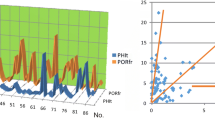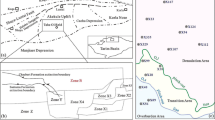We describe a statistical method for determining the fracture parameters and the vertical and lateral distribution of these parameters. We examine the correlation between the fracture properties and the filtration characteristics: permeability and deliverability. The grid method is an accurate and efficient tool that makes it possible to describe the surface density of fractures in the core. The parameters determined from the core can be used to calibrate the results from interpretation of well logging data, in order to sufficiently accurately determine the nature of the change in the parameters across the entire wellbore. We have established that the permeability and deliverability of the deposits clearly depends on the fracture spacing and the fracture surface density within the Dabei block of the Kuqa depression.



Similar content being viewed by others
References
D. D. Pollard and A. Aydin, “Progress in understanding jointing over the past century,” Bull. Geol. Soc. Am., 100, 1811–1204 (1988).
Lianbo Zeng and Xiang-Yang Li , “Fractures in sandstone reservoirs with ultra-low permeability: A case study of the Upper Triassic Yanchang Formation in the Ordos Basin, China,” AAPG Bulletin, 93, No. 4, 461–477 (2009).
Zhengzhang Zhao, Jinhu Du, Caineng Zou et al., “Geological exploration theory for large oil and gas provinces and its significance,” Petroleum Exploration and Development, 38, No. 5, 513–522 (2011).
Chunshu Luo, Haijun Yang, Jianghai Li et al., “Characteristics of high quality Ordovician reservoirs and controlling effects of faults in the Tazhong area,Tarim Basin,” Petroleum Exploration and Development, 38, No. 6, 716–724 (2011).
Wenzhi Zhao, Anjiang Shen, Suyun Hu et al., “Geological conditions and distributional features of large-scale carbonate reservoirs onshore China,” Petroleum Exploration and Development, 39, No. 1, 1–12 (2012).
F. J. Lucia, Carbonate Reservoir Characterization: An Integrated Approach, Springer (2007).
Mohammed S. Ameen, Keith MacPherson, Maher I. Al-Marhoon, and Zillur Rahim, “Diverse fracture properties and their impact on performance in conventional and tight-gas reservoirs, Saudi Arabia:The Unayzah, South Haradh case study,” AAPG Bulletin, 96, No. 3, 459–492 (2012).
Shengli Yao, Zhiqiang Zhang, Tinghui Li, and Anyuan Yang, “Application of 3D modeling technique to reservoir prediction within complex fault-block oil field,” in: SEG San Antonio 2011 Annual Meeting (2011), pp. 2019–2023.
Julia F. W. Gale, Robert M. Reed, and Jon Holder, “Natural fractures in the Barnett Shale and their importance for hydraulic fracture treatments,” AAPG Bulletin, 91, No. 4, 603–622 (2007).
Kajari Ghosh and Shankar Mitra, “Structural controls of fracture orientations, intensity, and connectivity, Teton anticline, Sawtooth Range, Montana,” AAPG Bulletin, 93, No. 8, 995–1014 (2009).
Olivier Lacombe, Nicolas Bellahsen, and Frederic Mouthereau, “Fracture patterns in the Zagros Simply Folded Belt (Fars, Iran): constraints on early collisional tectonic history and role of basement faults,” Geol. Mag. 148, Nos. 5–6, 940–963 (2011). doi:10.1017/S001675681100029X.
Jan Witte, Massimo Bonora, Carlos Carbone, and Onno Oncken, “Fracture evolution in oil-producing sills of the Rio Grande Valley, northern Neuquen Basin, Argentina,” AAPG Bulletin, 96, No. 7, 1253–1277 (2012).
Jinhu Du, Zhaoming Wang, Suyun Hu et al., “Formation and geological characteristics of deep giant gas provinces in the Kuqa foreland thrust belt, Tarim Basin, NW China,” Petroleum Exploration and Development, 39, No. 4, 385–393 (2012).
Author information
Authors and Affiliations
Additional information
Translated from Khimiya i Tekhnologiya Topliv i Masel, No. 4, pp. 41 – 44, July – August, 2013.
Rights and permissions
About this article
Cite this article
Haizhou, Q., Zhenyu, W., Fuxiang, Z. et al. Quantitative Fracture Characterization Method and its Application in the Bashijiqike Formation. Chem Technol Fuels Oils 49, 342–347 (2013). https://doi.org/10.1007/s10553-013-0451-7
Published:
Issue Date:
DOI: https://doi.org/10.1007/s10553-013-0451-7




